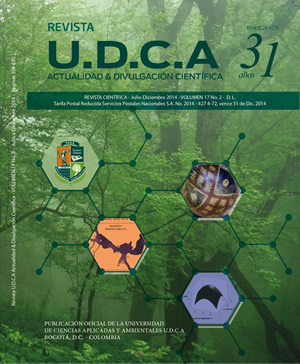Interacción de microorganismos benéficos en plantas: Micorrizas, Trichoderma spp. y Pseudomonas spp. una revisión
A review of interaction of beneficial microorganisms in plants: Mycorrhizae, Trichoderma spp. and Pseudomonas spp.
Contenido principal del artículo
Resumen
Existe una amplia gama de interrelaciones entre especies de microorganismos en los ecosistemas, tales como sinérgicas, antagónicas, de competencia física y bioquímica, moduladas por múltiples y complejos factores bióticos y abióticos. En la rizósfera, uno de los principales sitios donde se presentan microorganismos, específicamente funcionales, como fijadores de nitrógeno, solubilizadores de fosfatos, promotores del crecimiento vegetal, biocontroladores y especies patogénicas, normalmente, compiten por espacio y por nutrientes. Estas interrelaciones entre microorganismos inciden en la interacción suelo-planta-microorganismos-ambiente y repercuten, de forma directa, en el crecimiento y en el desarrollo de las especies vegetales. Microorganismos rizosféricos, como los hongos formadores de micorrizas arbusculares (AMF), hongos del género Trichoderma y bacterias del género Pseudomonas, usualmente, catalogados como agentes de control biológico (BCA) y microorganismos promotores del crecimiento vegetal (PGPM), dependen de los factores mencionados para expresar sus potenciales efectos benéficos; sin embargo, en la interacción de estos tres tipos de microorganismos, se pueden presentar efectos sinérgicos, que potencialicen los beneficios o, por el contrario, efectos antagónicos o simplemente que no ocurra ningún efecto en el crecimiento y en el desarrollo de las plantas. De acuerdo a lo anterior, el propósito de esta revisión es brindar información que permita comprender algunas de las interacciones entre microorganismos y, de esta manera, lograr dilucidar la aplicabilidad de la co-inoculación de BCA y PGPM de diferentes especies, con un objetivo común, el control o la regulación biológica de fitopatógenos y, como efecto conjunto y paralelo, la estimulación del crecimiento vegetal.
Palabras clave:
Descargas
Datos de publicación
Perfil evaluadores/as N/D
Declaraciones de autoría
- Sociedad académica
- Universidad de Ciencias Aplicadas UDCA
- Editorial
- Universidad de Ciencias Aplicadas y Ambientales U.D.C.A
Detalles del artículo
Referencias (VER)
ADHILAKSHMI, M.; KARTHIKEYAN, M.; ALICE, D. 2008. Effect of combination of bio-agents and mineral nutrients for the management of alfalfa wilt pathogen Fusarium oxysporum f. sp. medicaginis. Phytopath. 99:274-281.
AKHTAR, M.S.; SIDDIQUI, Z.A. 2008. Biocontrol of a root-rot disease complex of chickpea by Glomus intraradices, Rhizobium sp. and Pseudomonas straita. Crop Prot. 27:410-417.
ALIYE, N.; FININSA, C.; HISKIAS, Y. 2008. Evaluation of rhizosphere bacterial antagonists for their potential to bioprotect potato (Solanum tuberosum) against bacterial wilt (Ralstonia solanacearum). Biol. Control. 47:282-288.
ALVES S., H.S.; DA SILVA R., R.; MACAGNAN, D.; DE ALMEIDA H.V, B.; BARACAT P., M.C.; MOUNTEERD, A. 2004. Rhizobacterial induction of systemic resistance in tomato plants: non-specific protection and increase in enzyme activities. Biol. Control. 29:288-295.
ANJAIAH, V.; THAKUR, R.P.; KOEDAM, N. 2006. Evaluation of bacteria and Trichoderma for biocontrol of pre-harvest seed infection by Aspergillus flavus in groundnut. Biocontrol Sci. Techn. 16(4):431-436.
AVIS, T.J.; GRAVEL, V.; ANTOUN, H.; TWEDDELL, R.J. 2008. Multifaceted beneficial effects of rhizosphere microorganisms on plant health and productivity. Soil Biology & Biochem. 40:1733-1740.
BAE, Y.S.; KNUDSEN, G.R. 2005. Soil microbial biomass influence on growth and biocontrol efficacy of Trichoderma harzianum. Biol. Control. 32:236-242.
BAILEY, B.A.; BAE, H.; STREM, M.D.; CROZIER, J; THOMAS, S.E.; SAMUELS, G.J.; VINYARD, B.T.; HOLMES, K.A. 2008. Antibiosis, mycoparasitism, and colonization success for endophytic Trichoderma isolates with biological control potential in Theobroma cacao. Biol. Control. 46:24-35.
BARDAS, G.A.; LAGOPODI, A.L.; KADOGLIDOU, K.; TZAVELLA-KLONARI, K. 2009. Biological control of three Colletotrichum lindemuthianum races using Pseudomonas chlororaphis PCL1391 and Pseudomonas fluorescens WCS365. Biol. Control. 49:139-145.
BEAUCHAMP, V.B.; WALZ, C.; SHAFROTH, P.B. 2009. Salinity tolerance and mycorrhizal responsiveness of native xeroriparian plants in semi-arid western USA. Applied Soil Ecology. 43:175-184.
BENNETT, A.J.; WHIPPS, J.M. 2008. Beneficial microorganism survival on seed, roots and in rhizosphere soil following application to seed during drum priming. Biol. Control. 44:349-361.
BERRY, C.; DILANTHA, F.W.G.; LOEWEN, P.C.; de KIEVIT, T.R. 2010. Lipopeptides are essential for Pseudomonas sp. DF41 biocontrol of Sclerotinia sclerotiorum. Biol. Control. 55:211-218.
BHARADWAJ, D.P.; LUNDQUIST, P-O,; ALSTRÖMA, S. 2008. Arbuscular mycorrhizal fungal spore-associated bacteria affect mycorrhizal colonization, plant growth and potato pathogens. Soil Biology & Biochemistry. 40:2494-2501.
BRIMNER, T.A.; BOLAND, G.J. 2003. A review of the non-target effects of fungi used to biologically control plant diseases. Agric. Ecosyst. Environ. 100:3-16.
BROWN, D. 2010. A mathematical model of the Gac/ Rsm quorum sensing network in Pseudomonas fluorescens. Biosystems. 101:200-212.
CARREÑO P., A.J.; BLANCO, V.J.O.; VILLEGAS, E.B. 2006. Selección de hongos biocontroladores de Phytophthora cactorum, agente causal de la pudrición radical y de corona en manzano. Agron. 14(1):89-96.
CHANDANIE, W.A.; KUBOTA, M.; HYAKUMACHI, M. 2009. Interactions between the arbuscular mycorrhizal fungus Glomus mosseae and plant growth-promoting fungi and their significance for enhancing plant growth and suppressing damping-off of cucumber (Cucumis sativus L.). Applied Soil Ecology. 41:336-341.
CHEUNG, K.C.; ZHANG, J.Y.; DENG, H.H.; OU, Y.K.; LEUNG, H.M.; WU, S.C.; WONG, M.H. 2008. Interaction of higher plant (jute), electrofused bacteria and mycorrhiza on anthracene biodegradation. Bioresource Technology. 99:2148-2155.
COSTA, R.; GOMES, N.C.M.; PEIXOTO, R.S.; RUMJANEK, N.; BERG, G.; MENDONÇA-HAGLER, L.C.S.; SMALLA, K. 2006. Diversity and antagonistic potential of Pseudomonas spp. associated to the rhizosphere of maize grown in a subtropical organic farm. Soil Biology & Biochemistry. 38:2434-2447.
DOUDS, D.D., Jr.; MILLNER, P.D. 1999. Biodiversity of arbuscular mycorrhizal fungi in agroecosystems. Agric. Ecosys. Environ. 74:77-93.
F AKHOURI, W.; WALKER, F.; VOGLER, B.; ARMBRUSTER, W.; BUCHENAUER, H. 2001. Isolation and identification of N-mercapto-4-formylcarbostyril, an antibiotic produced by Pseudomonas fluorescens. Phytochem. 58:1297-1303.
F GAIER, H.; EBERL, H.J. 2010. A competition model between Pseudomonas fluorescens and pathogens via iron chelation. J. Theoret. Biol. 263:566-578.
F GAIER, H.; FEHER, B.; MCKELLAR, R.C.; EBERL, H.J. 2008. Predictive modeling of siderphore production by Pseudomonas fluorescensunder iron limitation. J. Theoret. Biol. 251:348-362.
F INLAY, R.D. 2004. Mycorrhizal fungi and their multifunctional roles. Mycologist. 18:91-96.
F RANKEN, P.; DONGES, K.; GRUNWALD, U.; KOST, G.; REXER, K.H.; TAMASLOUKH, M.; WASCHKE, A.; ZEUSKE, D. 2007. Gene expression analysis of arbuscule development and functioning Phytochem. 68:68-74.
GARCÍA, R.; RIERA, R.; ZAMBRANO, C.; GUTIÉRREZ. L. 2006. Desarrollo de un fungicida biológico a base de una cepa del hongo Trichoderma harzianum proveniente de la región andina venezolana. Fitosanidad. 10(2):115-121.
GERA H., W.H.; COOK, R. 2005. An overview of arbuscular mycorrhizal fungi–nematode interactions. Basic and Applied Ecology. 6:489-503.
GOSLING, P.; HODGE, A.; GOODLASS, G.; BENDING, G.D. 2006. Arbuscular mycorrhizal fungi and organic farming Agric. Ecosyst. Environ. 113:17-35.
GRYNDLER, M.; VOSÁTKA, M.; HRŠELOVÁ, H.; CATSKÁ, V.; CHVÁTALOVA, I.; JANSA, J. 2002. Effect of dual inoculation with arbuscular mycorrhizal fungi and bacteria on growth and mineral nutrition of strawberry. J. Plant Nutr. 25:1342-1358.
GUO, J.H.; QI, H.Y.; GUO, Y.H.; GE, H.L.; GONG, L.Y.; ZHANG, L.X.; SUN, P.H. 2004. Biocontrol of tomato wilt by plant growth-promoting rhizobacteria. Biol. Control. 29:66-72.
HARMAN, G.E.; PETZOLDT, R.; COMIS, A.; CHEN, J. 2004. Interactions Between Trichoderma harzianum strain T22 and maize inbred line Mo17 and effects of these interactions on diseases caused by Pythium ultimumi and Colletotrichum graminicola. Phytopath. 94:147-153.
HARMAN, G.E. 2006. Overview of mechanisms and uses of Trichoderma spp. Phytopath. 96:190-194.
HAUSE, B.; MROSK, C.; ISAYENKOV, S.; STRACK, D. 2007. Jasmonates in arbuscular mycorrhizal interactions. Phytochem. 68:101-110.
HAUSE, B.; SCHAARSCHMID, S. 2009. The role of jasmonates in mutualistic symbioses between plants and soil-born microorganisms. Phytochem. 70:1589-1599.
HOITINK, H.A.J.; MADDEN, L.V.; DORRANCE, A.E. 2006. Systemic resistance induced by Trichoderma spp.: Interactions between the host, the pathogen, the biocontrol agent, and soil organic matter quality. Phytopath. 96:186-189.
HOWELL, C.R.; PUCKHABER, L.S. 2005. A study of the characteristics of "P" and "Q" strains of Trichoderma virens to account for differences in biological control efficacy against cotton seedling diseases. Biol. Control. 33:217-222.
HOWELL, C.R. 2006. Understanding the mechanisms employed by Trichoderma virens to effect biological control of cotton diseases. Phytopath. 96(2):178-180.
HOYOS C., L.M.; CHAPARRO, P.; ABRAMSKY, M.; CHET, I.; ORDUZ, S. 2008. Evaluación de aislamientos de Trichoderma spp. contra Rhizoctonia solani y Sclerotium rolfsii bajo condiciones in vitro y de invernadero. Agron. Col. 26(3):451-458.
HOYOS C., L.M.; ORDUZ, S.; BISSETT, J. 2009. Growth stimulation in bean (Phaseolus vulgaris L.) by Trichoderma. Biol. Control. 51:409-416.
JETIYANON, K.; KLOEPPER, J.W. 2002. Mixtures of plant growth-promoting rhizobacteria for induction of systemic resistance against multiple plant diseases. Biol. Control. 29:34-42.
JI, P.; CAMPBELL, H.L.; KLOEPPER, J.W.; JONES, J.B.; SUSLOW, T.V.; WILSON, M. 2006. Integrated biological control of bacterial speck and spot of tomato under Weld conditions using foliar biological control agents and plant growth-promoting rhizobacteria. Biol. Control. 36:358-367.
KAPOOR, R.; SHARMA, D.; BHATNAGAR, A.K. 2008. Arbuscular mycorrhizae in micropropagation systems and their potential applications. Scientia Horticulturae. 116:227-239.
KARTHIKEYAN, V.; SANKARALINGAM, A.; NAKKEERAN, S. 2006a. Management of groundnut root rotwith biocontrol agents and organic amendments. Phytopathology and Plant Protection. 39(3):215-223.
KARTHIKEYAN, V.; SANKARALINGAM, A.; NAKKEERAN, S. 2006b. Biological control of groundnut stem rot caused by Sclerotium rolfsii (Sacc.). Phytopathology and Plant Protection. 39(3):239-246.
KARTHIKEYAN, M.; RADHIKA, K.; BHASKARAN, R.; MATHIYAZHAGAN, S.; SANDOSSKUMAR, R.; VELAZHAHAN, R.; ALICE, D. 2008. Biological control of onion leaf blight disease by bulb and foliar application of powder formulation of antagonist mixture. Phytopathology and Plant Protection. 41(6):407-417.
KAUR, R.; MACLEOD, J.; FOLEY, W.; NAYUDU, M. 2006. Gluconic acid: An antifungal agent produced by Pseudomonas species in biological control of take-all. Phytochem. 67:595-604.
LATHA, P.; ANAND, T.; RAGUPATHI, N.; PRAKASAM, V.; SAMIYAPPAN, R. 2009. Antimicrobial activity of plant extracts and induction of systemic resistance in tomato plants by mixtures of PGPR strains and Zimmu leaf extract against Alternaria solani. Biol. Control. 50:85- 93.
LEANDRO, L.F.S.; GUZMAN, T.; FERGUSON, L.M.; FERNANDEZ, G.E.; LOUWS, F.J. 2007. Population dynamics of Trichoderma in fumigated and compostamended soil and on strawberry roots. Applied Soil Ecology. 35:237-246.
LIOUSSANNE, L.; PERREAULT, F.; JOLICOEUR, M.; STARNAUD, M. 2010. The bacterial community of tomato rhizosphere is modified by inoculation with arbuscular mycorrhizal fungi but unaffected by soil enrichment with mycorrhizal root exudates or inoculation with Phytophthora nicotianae. Soil Biology & Biochemistry. 42:473-483.
LÓPEZ-MONDÉJAR, R.; ROS, M.; PASCUAL, J.A. 2011. Mycoparasitism-related genes expression of Trichoderma harzianum isolates to evaluate their efficacy as biological control agent. Biol. Control. 56(1):59-66.
LUGTENBERG, B.J.J.; DEKKERS, L.; BLOEMBERG, G.V. 2001. Molecular determinants of rhizosphere colonization by Pseudomonas. Ann. Rev. Phytopathol. 39:461-90.
MALUSA, E.; SAS-PASZT, L.; POPINSKA, W.; ZURAWICZ, E. 2007. The Effect of a Substrate Containing Arbuscular Mycorrhizal fungi and rhizosphere microorganisms (Trichoderma, Bacillus, Pseudomonas and Streptomyces) and foliar fertilization on growth response and rhizosphere pH of three strawberry cultivars. Internal J. Fruit Sci. 6(4):25-41.
MARSCHNER, P.; TIMONEN, S. 2005. Interactions between plant species and mycorrhizal colonization on the bacterial community composition in the rhizosphere. Applied Soil Ecology. 28:23-36.
MATIAS, S.R.; PAGANO, M.C.; MUZZI, F.C.; OLIVEIRA, C.A.; CARNEIRO, A.A.; HORTA, S.N.; SCOTTI, M.R. 2009. Effect of rhizobia, mycorrhizal fungi and phosphate-solubilizing microorganisms in the rhizosphere of native plants used to recover an iron ore area in Brazil. European J. Soil Biology. 45:259-266.
MELO, I.S.; FAULL, J.L.; GRAEME-COOK, K.A. 1997. Relationship between in vitro cellulase production of uv-induced mutants of Trichoderma harzianum and their bean rhizosphere competence. Mycol. Res. 101(11):1389-1392.
MOHANDAS, S.; MANJULA, R.; RAWAL, R.D.; LAKSHMIKANTHA, H.C.; CHAKRABORTY, S.; RAMACHANDRA, Y.L. 2010. Evaluation of arbuscular mycorrhiza and other biocontrol agents in managing Fusarium oxysporum f. sp. Cubense infection in banana cv. Neypoovan. Biocontrol Sci. Techn. 20(2):165-181.
MOMMAERTS, V.; PLATTEAU, G.; BOULET, J.; STERK, G.; SMAGGHE, G. 2008. Trichoderma-based biological control agents are compatible with the pollinator Bombus terrestris: A laboratory study. Biol. Control 46: 463-466.
NEUHAUSER, C.; FARGIONE, J.E. 2004. A mutualism– parasitism continuum model and its application to plant–mycorrhizae interactions. Ecological Modelling. 177:337-352.
OKUBARA, P.A.; CALL, D.R.; KWAK, Y.S.; SKINNER, D.Z. 2010. Induction of defense gene homologues in wheat roots during interactions with Pseudomonas fluorescens. Biol. Control. 55:118-125.
OLSON, H.A.; BENSON, D.M. 2007. Induced systemic resistance and the role of binucleate Rhizoctonia and Trichoderma hamatum 382 in biocontrol of Botrytis blight in geranium. Biol. Control. 42:233-241.
OYEKANMI, E.O.; COYNE, D.L.; FAGADE, O.E.; OSONUBI, O. 2007. Improving root-knot nematode management on two soybean genotypes through the application of BradyRhizobium japonicum, Trichoderma pseudokoningii and Glomus mosseae in full factorial combinations. Crop Prot. 26:1006-1012.
POZO, M.A.; AZCÓN-AGUILAR, C. 2007. Unraveling mycorrhiza-induced resistance. Plant Biology. 10:393- 398.
RADJACOMMARE, R.; VENKATESAN, S.; SAMIYAPPAN, R. 2010. Biological control of phytopathogenic fungi of vanilla through lytic action of Trichoderma species and Pseudomonas fluorescens. Phytopathology and Plant Protection. 43(1):1-17.
RAVNSKOV, S.; JENSEN, B.; KNUDSEN, I.M.B.; BØDKER, L.; JENSEN, D.F.; KARLINSKI, L.; LARSEN, J. 2006 Soil inoculation with the biocontrol agent Clonostachys rosea and the mycorrhizal fungus Glomus intraradices results in mutual inhibition, plant growth promotion and alteration of soil microbial communities. Soil Biology & Biochemistry. 38:3453- 3462.
ROSAS, S.B.; VANZINI, G.; CARLIER, E.; PASLUOSTA, C.; PASTOR, N.; ROVERA, M. 2009. Root colonization and growth promotion of wheat and maize by Pseudomonas aurantiaca SR1. Soil Biology & Biochemistry. 41:1802-1806.
RUANO R., D.; LÓPEZ H, C.J. 2009. Evaluation of Trichoderma spp. as biocontrol agents against avocado white root rot. Biol. Control. 51: 66-71.
SELOSSE, M.A.; BAUDOIN, E.; VANDENKOORNHUYSE, P. 2004. Symbiotic microorganisms, a key for ecological success and protection of plants. C. R. Biologies. 327:639-648.
SHARMA, M.P.; ADHOLEYA, A. 2004. Effect of arbuscular mycorrhizal fungi and phosphorus fertilization on the post vitro growth and yield of micropropagated strawberry grown in a sandy loam soil. Can. J. Bot. 82:322-328.
SIDDIQUI, I.A.; SHAUKAT, S.S. 2003. Suppression of root-knot disease by Pseudomonas fluorescens CHA0 in tomato: importance of bacterial secondary metabolite, 2,4-diacetylpholoroglucinol. Soil Biology & Biochemistry. 35:1615-1623.
SIDDIQUI, Z.A.; AKHTAR, M.S. 2008. Synergistic effects of antagonistic fungi and a plant growth promoting rhizobacterium, an arbuscular mycorrhizal fungus, or composted cow manure on populations of Meloidogyne incognita and growth of tomato. Biocontrol Sci. Techn. 18(3):279-290.
SPENCER, M.; RYU, C.M.; YANG, K.Y.; KIM, Y.C.; KLOEPPER, J.W.; ANDERSON, A.J. 2003. Induced defence in tobacco by Pseudomonas chlororaphis strain O6 involves at least the ethylene pathway. Physiological and Molecular Plant Pathology. 63:27-34.
STANLEY, J.; CHANDRASEKARAN, S.; PREETHA, G.; KUTTALAM, S. 2010. Physical and biological compatibility of diafenthiuron with micro/macro nutrients fungicides and biocontrol agents used in cardamom. Phytopathology and Plant Protection. 43(14):1396-1406.
STURZ, A.V.; CHRISTIE, B.R. 2003. Beneficial microbial allelopathies in the root zone: the management of soil quality and plant disease with rhizobacteria. Soil & Tillage Res. 72:107-123.
VARGA, S.; KYTÖVIITA, M.M. 2010. Interrelationships between mycorrhizal symbiosis, soil pH and plant sex modify the performance of Antennaria dioica. Acta Oecologica. 36:291-298.
VÁZQUEZ, M.M.; CÉSAR, S.; AZCÓN, R.; BAREA, J.M. 2000. Interactions between arbuscular mycorrhizal fungi and other microbial inoculants (Azospirillum, Pseudomonas, Trichoderma) and their effects on microbial population and enzyme activities in the rhizosphere of maize plants. Applied Soil Ecology. 15:261-272.
VERMA, M.; BRAR, S.K.; TYAGI, R.D.; SURAMPALLI, R.Y.; VALÉRO, J.R. 2007. Antagonistic fungi, Trichoderma spp.: Panoply of biological control. Biochemical Engineering J. 37:1-20.
VINALE, F.; SIVASITHAMPARAM, K.; GHISALBERTI, E.L.; MARRA, R.; BARBETTI, M.J.; LI, H.; WOO, S.L.; LORITO, M. 2008a. A novel role for Trichoderma secondary metabolites in the interactions with plants. Physiological and Molecular Plant Pathology. 72:80-86.
VINALE, F.; SIVASITHAMPARAM, K.; GHISALBERTI, E.L.; MARRA, R.; WOO, S.L.; LORITO, M. 2008b. Trichoderma–plant–pathogen interactions. Soil Biology & Biochemistry. 40:1-10.
WALTERS, D.R. 2009. Are plants in the field already induced? Implications for practical disease control. Crop Prot. 28:459-465.
WEHNER, J.; ANTUNES, P.M.; POWELL, J.; MAZUKATOW, J.; RILLIG, M.C. 2010. Plant pathogen protection by arbuscular mycorrhizas: A role for fungal diversity? Pedobiologia. 53:197-201.
WELC, M.; RAVNSKOV, S.; KIELISZEWSKA-ROKICKA, B.; LARSEN, J. 2010. Suppression of other soil microorganisms by mycelium of arbuscular mycorrhizal fungi in root-free soil. Soil Biology & Biochemistry. 42:1534-1540.
WRIGHT, B.; ROWSE, H.R.; WHIPPS, J.M. 2003. Application of Beneficial Microorganisms to Seeds during Drum Priming. Biocontrol Sci. Techn. 13(6):599- 614.
YASIR, M.; ASLAM, Z.; KIM, S.W.; LEE, S.W.; JEON, C.O.; CHUNG, Y.R. 2009. Bacterial community composition and chitinase gene diversityof vermicompost with antifungal activity. Bioresource Technology. 100:4396- 4403.







